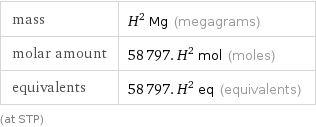Input interpretation

H^2 Mg of hydroxide anion
Basic properties for H^2 Mg

mass | H^2 Mg (megagrams) molar amount | 58797. H^2 mol (moles) equivalents | 58797. H^2 eq (equivalents) (at STP)
Mass composition for H^2 Mg

O (oxygen) | 0.9407 H^2 Mg (94.1%) H (hydrogen) | 0.05927 H^2 Mg (5.9%)
Lewis structure

Draw the Lewis structure of hydroxide anion. Start by drawing the overall structure of the molecule: Count the total valence electrons of the hydrogen (n_H, val = 1) and oxygen (n_O, val = 6) atoms, including the net charge: n_H, val + n_O, val - n_charge = 8 Calculate the number of electrons needed to completely fill the valence shells for hydrogen (n_H, full = 2) and oxygen (n_O, full = 8): n_H, full + n_O, full = 10 Subtracting these two numbers shows that 10 - 8 = 2 bonding electrons are needed. Each bond has two electrons, so the above diagram has all the necessary bonds. There is 1 bond and hence 2 bonding electrons in the diagram. Fill in the remaining unbonded electrons on each atom. In total, there remain 8 - 2 = 6 electrons left to draw. Lastly, fill in the formal charges: Answer: | |
General properties

formula | (OH)^- net ionic charge | -1 alternate names | hydroxide | hydroxide(1-)